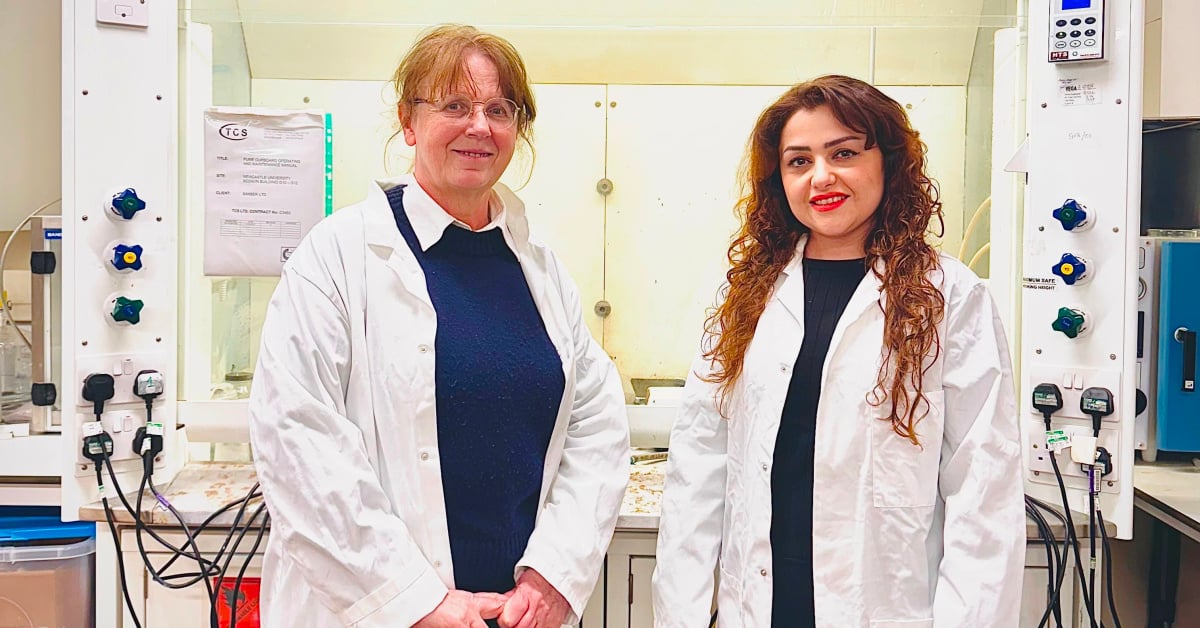Can recycled plastic help to reduce your energy bills?
16 April 2025 | By: Professor Lidija Šiller | 3 min read
Newcastle University researchers have developed a mortar made from recycled plastic and silica aerogel which improves insulation and reduces plastic waste.
At a time when energy efficiency and sustainability are at the forefront of engineering and construction, innovative materials are shaping the future of building design.
Our latest research authored by Professor of Nanoscale Science Lidija Šiller and Postgraduate Researcher Kaniaw Marof, and published in Construction and Building Materials, explores the groundbreaking combination of silica aerogel and recycled PET plastic to develop an advanced cement mortar with superior thermal insulation properties. Prof Šiller writes about what this could mean for you.
Contents:
- The challenge: energy efficiency in buildings
- The innovation: a new cement mortar composite
- What is silica aerogel?
- What is PET plastic?
- What have studies shown so far?
- Why this matters
- Industry applications and future research
- Join the conversation
The challenge: energy efficiency in buildings
Buildings account for a significant portion of global energy consumption, with increasing heating and cooling demands driving up energy costs.
'Wouldn’t it be wonderful to reduce heating bills of all our new builds and at the same time significantly reduce plastic waste in the world?' Lidija Šiller, Professor of Nanoscale Science
Traditional construction materials, particularly masonry, contribute to significant thermal inefficiencies. This leads to excessive heat loss and as climate change accelerates, there is an urgent need to incorporate sustainable, high-performance insulation materials in construction.
The innovation: a new cement mortar composite
But our team may have found a solution.
Our study is among the first to integrate surface-modified silica aerogel and recycled PET plastic into cement-based mortar.
By partially replacing natural sand with these materials, we achieved remarkable improvements in thermal insulation while maintaining the mechanical integrity required to keep the building structure sound.
Seven different formulations were tested alongside traditional mortar. The most effective of the new mortar mixes consisted of 7% untreated silica aerogels replacing natural sand combined with 3% recycled PET (polyethene terephthalate) plastic.
The PET plastic particles used in the study came from shredded plastic bottles waste. Our team washed the plastic pieces with water after shredding and left them to dry at room temperature for 24 hours.
Next, we analysed key properties, such as setting time, flowability (a measure to determine the workability of cement mortar), density, strength, and thermal conductivity.

Professor Lidija Šiller and postgraduate researcher Kaniaw Marof in the lab. Credit: Lidija Šiller.
What is silica aerogel?
Silica aerogel is a synthetic porous material made from a gel where the liquid is removed, leaving behind a solid structure with air-filled pores. It consists of over 95% air, giving it ultra-low thermal conductivity (~0.02 W/m.K).
Silica aerogels are used in various technological areas, including space suits, chromatography, and building insulation, due to their excellent thermal insulation properties.
What is PET plastic?
PET, or polyethylene terephthalate, is a thermoplastic polymer resin, meaning it can be heated, melted, and cooled into different shapes. It's a type of polyester, derived from petroleum and natural gas.
PET is a common, durable, and lightweight plastic, often used for packaging food, fibre production, and in engineering plastics. It is easily recyclable, and considered a sustainable material due to its recyclability and the potential to reduce reliance on virgin materials. As a result, PET particles enhance the new composite's sustainability by reducing density and improving ductility, thereby diverting plastic waste from landfills.
What have studies shown so far?
Our work in the journal Construction and Building Materials demonstrates that the new mortar mix reduced heat loss by up to 55% compared to conventional mortar, while maintaining the required strength for masonry construction.
It also meets international standards (BS-EN 413-1:2011, ASTM C270-10, AS 1012/AS 3700), presenting an eco-friendly alternative for energy-efficient and sustainable construction.
This could improve sustainable construction practices while reducing heat loss in buildings, in areas where you get thermal bridging, for example through gaps between bricks in the walls which are filled with mortar. The new mortar also aligns with circular economy principles, in that it eliminates waste and pollution and circulates products through design.
Why this matters
Ultimately, this research bridges the gap between sustainability and high-performance construction materials. By integrating aerogels and recycled plastics, this new material could enable the creation of energy-efficient buildings that reduce carbon footprints without compromising structural integrity.
At a time when we all must contribute to reducing the impacts of climate change, developments like these are essential in meeting future energy regulations and promoting environmentally friendly construction practices.
Industry applications and future research
The potential applications of this mortar extend beyond conventional masonry. It can be utilised in thermal bridge reduction, lightweight prefabricated panels, and energy-efficient retrofitting projects.
Future research will focus on scaling production and optimising mechanical properties to expand industrial applications.
Join the conversation
Collaboration between academia, industry professionals, and policymakers is crucial as the construction sector moves towards greener alternatives. We invite researchers, engineers, and sustainability advocates to engage with our work, explore further applications, and contribute to a more energy-efficient built environment.
For more details, read our complete Construction and Building Materials study.
You might also like
- read the study: Kaniaw Marof, Lidija Šiller, Enhancing thermal insulation in cement mortar with silica aerogel and recycled PET plastic, Construction and Building Materials, Volume 467, 2025, 140320, ISSN 0950-0618, https://doi.org/10.1016/j.conbuildmat.2025.140320
- read the press release: ‘New environmentally-friendly mortar reduces heat loss’
- find out more about the work of Professor Lidija Šiller, Professor of Nanoscale Science at the School of Engineering, Newcastle University
- explore research and facilities at Newcastle University’s nanoLAB
- discover world-leading research from our School of Engineering
